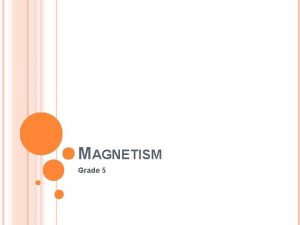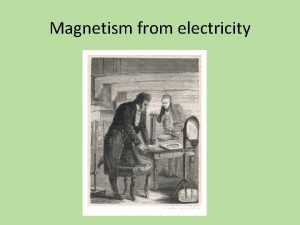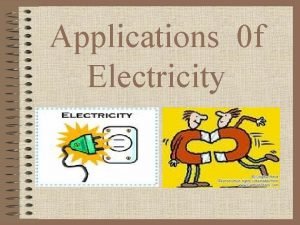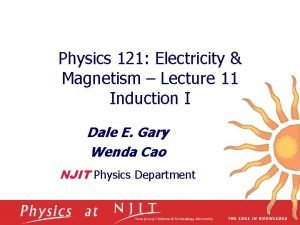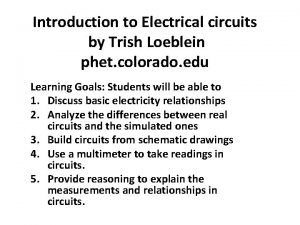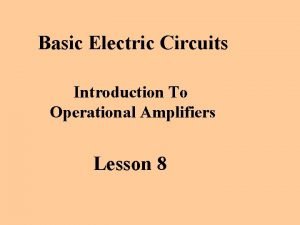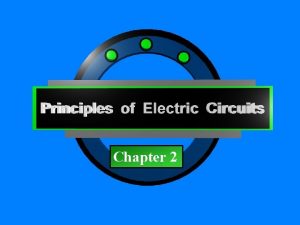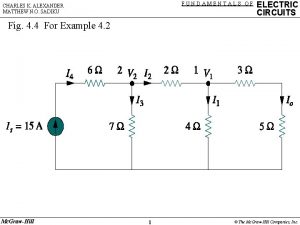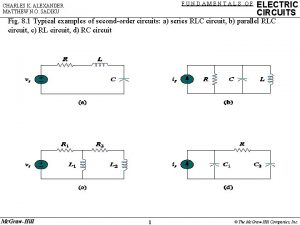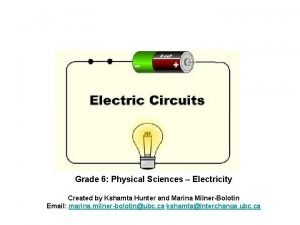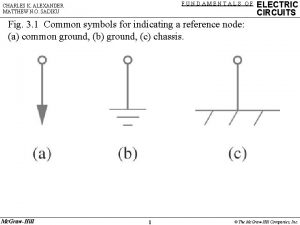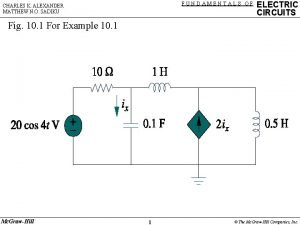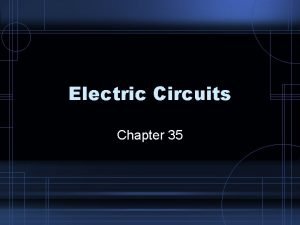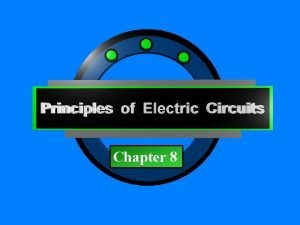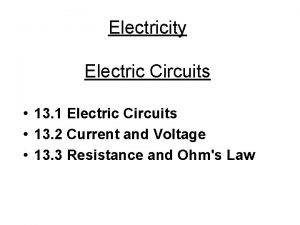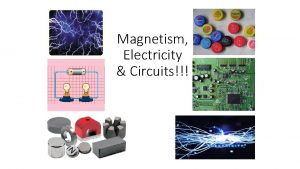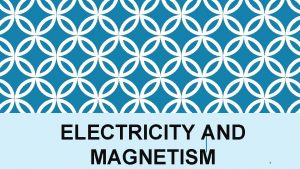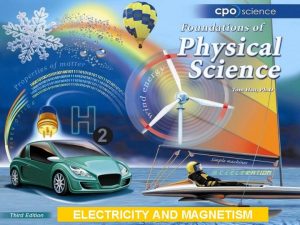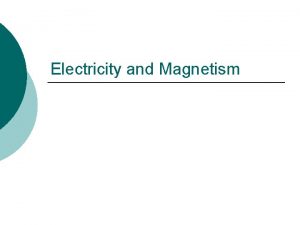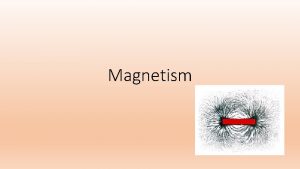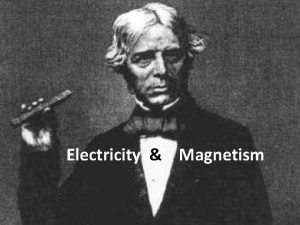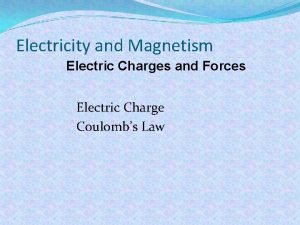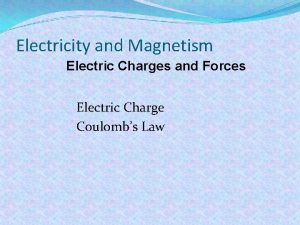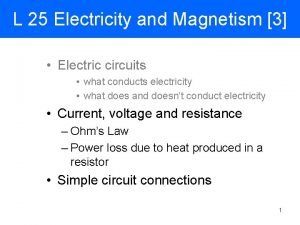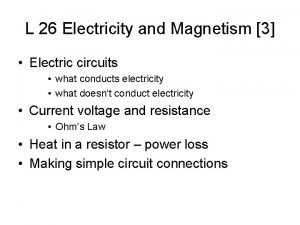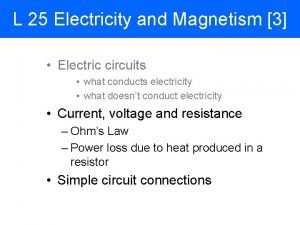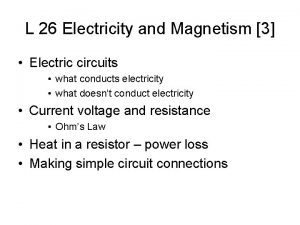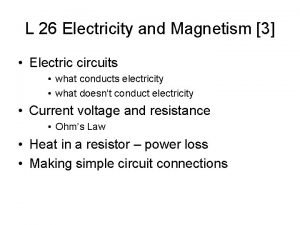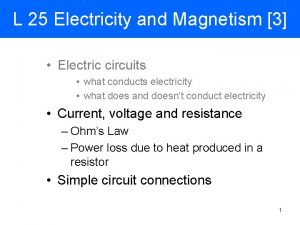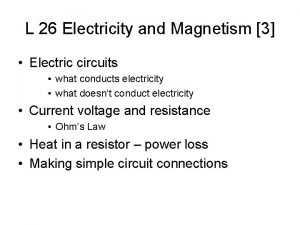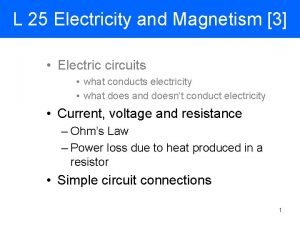Electricity and Magnetism Electricity 19 1 Electric Circuits






































- Slides: 38

Electricity and Magnetism Electricity § 19. 1 Electric Circuits § 19. 2 Current and Voltage § 19. 3 Electrical Resistance and Ohm’s Law

Chapter 19 Objectives 1. Describe the difference between current and voltage. 2. Describe the connection between voltage, current, energy, and power. 3. Describe the function of a battery in a circuit. 4. Calculate the current in a circuit using Ohm’s law. 5. Draw and interpret a circuit diagram with wires, battery, bulb, and switch. 6. Measure current, voltage, and resistance with a multimeter. 7. Give examples and applications of conductors, insulators, and semiconductors.

Chapter 19 Vocabulary Terms § § § § § electricity electric current voltage resistance Ohm’s law battery open circuit closed circuit short circuit § switch § circuit diagram § electrical conductivity § potentiometer § wire § volt § electrical symbols § amperes (amps) § § § multimeter ohm resistor ammeter electrical insulator § semiconductor § electric circuit

19. 1 Electric Circuits Key Question: What is an electric circuit? *Students read Section 19. 1 AFTER Investigation 19. 1

19. 1 Electric Circuits § Electricity refers to the presence of electric current in wires, motors, light bulbs, and other devices. § Electric current is similar to a current of water, but electric current flows in solid metal wires so it is not visible. § Electric current can carry a lot of power.

19. 1 Electric Circuits § An electric circuit is something that provides a complete path through which electricity travels. § Wires in electric circuits are similar in some ways to pipes and hoses that carry water.

19. 1 Electric Circuits § When drawing a circuit diagram, symbols are used to represent each part of the circuit. § These electrical symbols are quicker and easier to draw than realistic pictures of the components.




19. 2 Current and Voltage Key Question: How does current move through a circuit? *Students read Section 19. 2 AFTER Investigation 19. 2

19. 2 Current and voltage § Electric current is measured in units called amperes, or amps (A) for short. § One amp is a flow of a certain quantity of electricity in one second. § The amount of electric current entering a circuit always equals the amount exiting the circuit.

19. 2 Current and voltage § Conventional current was proposed by Ben Franklin in the 1700’s. § Scientists later discovered that the particles that carry electricity in a wire actually travel from negative to positive. § Today, we still use Franklin’s definition.

19. 2 Voltage § Voltage is a measure of electric potential energy, just like height is a measure of gravitational potential energy. § Voltage is measured in volts (V). § A voltage difference of 1 volt means 1 amp of current does 1 joule of work in 1 second.

19. 2 Voltage § Since 1 joule per second is a watt (power), you can interpret voltage as measuring the available electrical power per amp of current that flows.

19. 2 Voltage § The positive end of a 1. 5 volt battery is 1. 5 volts higher than the negative end. § If you connect batteries positive-to-negative, each battery adds 1. 5 volts to the total. § Three batteries make 4. 5 volts. § Each unit of current coming out of the positive end of the three-battery stack has 4. 5 joules of energy.

19. 2 Measuring voltage of a cell § Set the meter to DC volts. § Touch the red (+) lead of the meter to the (+) battery terminal. § Touch the black (-) lead of the meter to the (-) battery terminal. § Adjust the meter dial as necessary.

19. 2 Measuring voltage in a circuit § Measure the voltage across the battery exactly as before. § DO NOT DISCONNECT THE CIRCUIT. NOTE: Since voltage is measured from one point to another, we usually assign the negative terminal of a battery to be zero volts (0 V).

19. 2 Current and voltage § A battery uses chemical energy to create a voltage difference between its two terminals. § In a battery, chemical reactions provide the energy to pump the current from low voltage to high voltage. § A fully charged battery adds energy proportional to its voltage.

19. 2 What does a battery do? § A battery uses chemical energy to move charges. § If you connect a circuit with a battery the charges flow out of the battery carrying energy.

19. 2 How do these batteries differ? § Some are smaller and don't store as much energy. § Other batteries made with Ni and Cd can be recharged. § Which battery above has the greatest voltage capacity?

19. 2 Measuring Current § In practical electricity, we still label current flowing from plus to minus or HIGH voltage to LOW voltage. § Current can't be measured unless the charges flow through the meter.

19. 2 Current is a flow of charge

19. 3 Electrical Resistance and Ohm’s Law Key Question: How are voltage, current, and resistance related? *Students read Section 19. 3 AFTER Investigation 19. 3

19. 3 Electrical resistance § Resistance measures how difficult it is for current to flow.

19. 3 Electrical Resistance § The total amount of electrical resistance in a circuit determines the amount of current that in the circuit for a given voltage. § The more resistance the circuit has, the less current that flows.

19. 3 Measuring resistance § Set the meter to measure resistance (W). § Set the black and red leads on opposite ends of the objects.

19. 3 The ohm § Resistance is measured in ohms (W). § One ohm is the resistance when a voltage of 1 volt is applied with a current of 1 amp.

19. 3 Ohm's law § German physicist Georg Ohm experimented with circuits to find an exact mathematical relationship between voltage, current and resistance. § Ohm's law can be used to predict any one of the three variable if given the other two.


19. 3 Calculate current § A light bulb with a resistance of 2 ohms is connected in a circuit that has a single 1. 5 -volt battery. § Calculate the current that flows in the circuit. § Assume the wires have zero resistance.

19. 3 The resistance of electrical devices § The resistance of electrical devices ranges from very small (0. 001 Ω) to very large (10× 106 Ω). § Each device is designed with a resistance that allows the right amount of current to flow when connected to the voltage the device was designed for.

19. 3 Changing resistance § The resistance of many materials, including those in light bulbs, increases as temperature increases. § A graph of current versus voltage for a light bulb shows a curve. § A device with constant resistance would show a straight line on this graph.

19. 3 Electrical Conductivity § The electrical conductivity describes a material’s ability to pass electric current.

19. 3 Conductors and insulators § A material such as copper is called a conductor because it can conduct, or carry, electric current. § Materials that insulate against (or block) the flow of current are classified as electrical insulators. § Some materials are neither conductors nor insulators. § These materials are named semiconductors.

19. 3 Resistors § Electrical components called resistors can be used to control current. § Resistors have striped color codes to record their "values" (writing on them is difficult).

19. 3 Potentiometers § Potentiometers are a type of "variable" resistor that can change from low to high. § They are wired so that as you turn the knob, it changes the distance the current has to flow.

Application: Hybrid Gas/Electric Cars
 Physics 102
Physics 102 Ib physics topic 5 questions
Ib physics topic 5 questions Magnetism
Magnetism Electricity jeopardy
Electricity jeopardy Sph3u electricity and magnetism
Sph3u electricity and magnetism Relationship between electricity and magnetism
Relationship between electricity and magnetism Magnetism and electricity
Magnetism and electricity Grade 5 electricity and magnetism
Grade 5 electricity and magnetism Electricity and magnetism
Electricity and magnetism Electricity and magnetism
Electricity and magnetism Ampere
Ampere Electricity and magnetism
Electricity and magnetism Electricity and magnetism
Electricity and magnetism Electricity and magnetism vocabulary
Electricity and magnetism vocabulary What is a parallel circuit in physics
What is a parallel circuit in physics James w nilsson
James w nilsson Basic electrical engineering kulshreshtha
Basic electrical engineering kulshreshtha Static electricity and current electricity
Static electricity and current electricity Static electricity and current electricity
Static electricity and current electricity Phet build a circuit
Phet build a circuit Fundamentals of electric circuits chapter 4 solutions
Fundamentals of electric circuits chapter 4 solutions Electric current
Electric current Conceptual physics chapter 35 electric circuits
Conceptual physics chapter 35 electric circuits Chapter 20 electric circuits
Chapter 20 electric circuits Electric circuits equations
Electric circuits equations 9
9 Fundamentals of electric circuits chapter 7 solutions
Fundamentals of electric circuits chapter 7 solutions Chapter 35 electric circuits answers
Chapter 35 electric circuits answers Ohm's law calculations worksheet
Ohm's law calculations worksheet Principle of electric circuit
Principle of electric circuit What are the three elements of electricity
What are the three elements of electricity Charles k. alexander matthew n. o. sadiku
Charles k. alexander matthew n. o. sadiku Sadiku
Sadiku Elec 202
Elec 202 Kshamta hunter
Kshamta hunter Alexander sadiku
Alexander sadiku Sadiku
Sadiku Chapter 35 electric circuits
Chapter 35 electric circuits The circuit chapter 8 summary
The circuit chapter 8 summary







